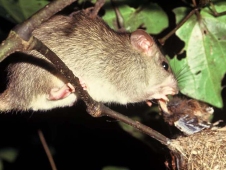
Invasive species of animals, plants and disease-causing micro-organisms have already caused numerous extinctions, and remain a particular threat to birds on oceanic islands. Certain diseases appear to be spreading to previously unaffected bird populations, some of which are already threatened by other factors. Global travel, worldwide trade and a changing climate are encouraging the further spread of invasives.
Invasive species are the main cause of recent bird extinctions View case study list
View case study list
Humans have been transporting animals and plants from one part of the world to another for thousands of years, sometimes deliberately as in the case of livestock, and companion animals such as cats and dogs and sometimes accidentally (for example rats escaping from boats). Often introduced species fail to establish themselves in the wild in new locations. However, a proportion thrives and spread. Such 'invasive alien species' may have catastrophic impacts on local fauna and flora. Invasive species can affect native ones by eating them, competing with them, hybridising with them, disrupting or destroying their habitat or, in the case of pathogens or parasites, by sickening or killing them. Over the last five hundred years, invasive alien species have been partly or wholly responsible for the extinction of at least 65 bird species, making this the most common contributory factor in recent losses to the world’s avifauna (![]() ).
).
Invasive species are a particular threat on islands View case study list
View case study list
Overall, invasive species affect around half of currently threatened bird species. Island species are particularly susceptible because of their isolated evolutionary history, with three-quarters of threatened birds on oceanic islands affected by invasive species (![]() ). Rats and cats have had far and away the greatest effect, threatening the survival of hundreds of different bird species worldwide, but other species can also have devastating impacts (
). Rats and cats have had far and away the greatest effect, threatening the survival of hundreds of different bird species worldwide, but other species can also have devastating impacts (![]() ,
, ![]() ,
, ![]() ).
).
Invasive diseases are a growing problem View case study list
View case study list
Diseases carried by invasive pathogens and parasites are already implicated in the decline and extinction of many bird species (![]() ). Some diseases, such as West Nile Virus, appear to be spreading to populations previously unaffected, including to species already threatened by other factors (
). Some diseases, such as West Nile Virus, appear to be spreading to populations previously unaffected, including to species already threatened by other factors (![]() ,
, ![]() ). ‘Bird flu’ is of particular concern, not because of direct impacts on wild birds, rather because it is leading to negative public perceptions towards birds (
). ‘Bird flu’ is of particular concern, not because of direct impacts on wild birds, rather because it is leading to negative public perceptions towards birds (![]() ).
).
Global travel, trade and a changing climate encourage the spread of invasive species View case study list
View case study list
Increases in human mobility and expansion of global trade encourage the spread of invasive species. Global climate change creates conditions suitable for new invasives. For example, increased temperatures potentially enable disease-carrying mosquitoes to expand their ranges. These factors, together with the degradation and fragmentation of natural habitats which make it easier for invasives to establish themselves, mean that invasive species are likely to become an increasing threat.